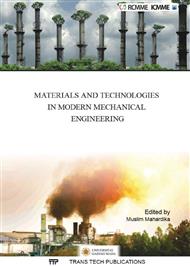p.3
p.7
p.14
p.19
p.24
p.31
p.36
p.43
p.53
Study of Active Compounds from Red Cabbage (Brassica oleracea var. capitata f. Rubra) Extract as a Green Corrosion Inhibitor for API 5L Grade X60 Steel in NaCl 3.5% Environment
Abstract:
Red cabbage extract has been investigated in this work whether it would perform as a green corrosion inhibitor for API 5L grade X60 steel in 3.5% NaCl environment. Based on the FTIR and LC-MS analysis the active compounds of corrosion inibitor were hydroxyl, carbonyl and cyanidin. The Tafel polarization test results showed that red cabbage extract performed as a mixed corrosion inhibitor and the Electrochemical Impedance Spectroscopy test results showed that the impedance, polarization resistance and capacitive resistance of steel surface increased with the addition of red cabbage corrosion inhibitor. Based on evaluation of the testing results red extract red cabbage performed significant corrosion inhibition effect. The inhibitor efficiency increases with increased corrosion inhibitor concentration and the optimum inhibitor percent efficiency achieved 81%. The adsorption mechanism of red cabbage corrosion inhibitor can be considered as a Langmuir Isotherm
Info:
Periodical:
Pages:
24-30
Citation:
Online since:
June 2016
Authors:
Price:
Сopyright:
© 2016 Trans Tech Publications Ltd. All Rights Reserved
Share:
Citation:


